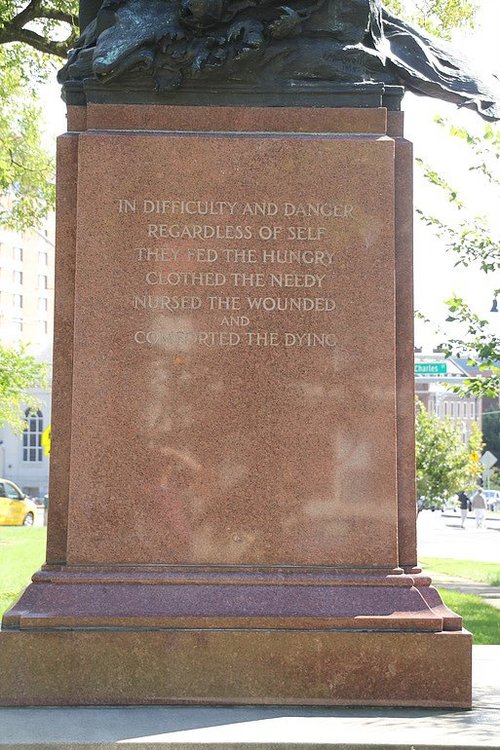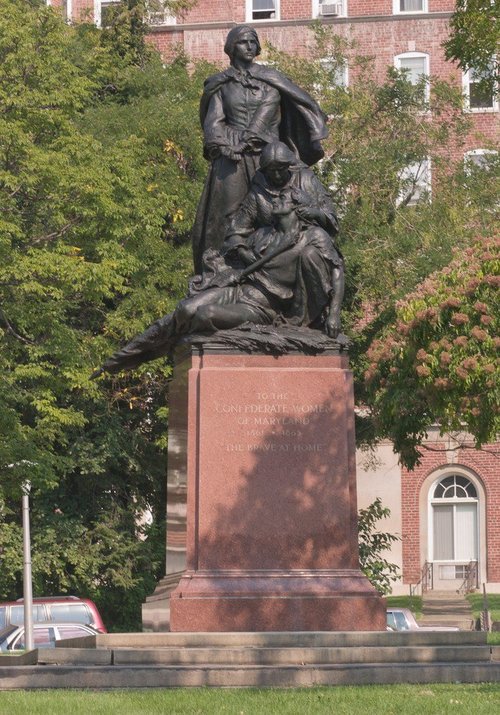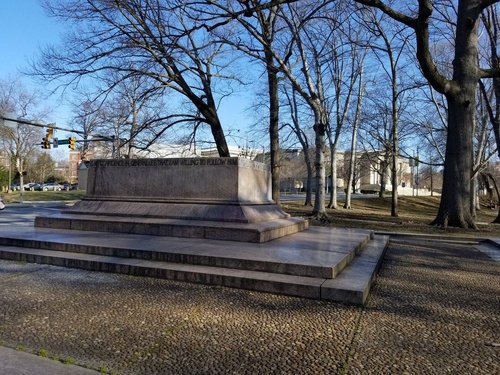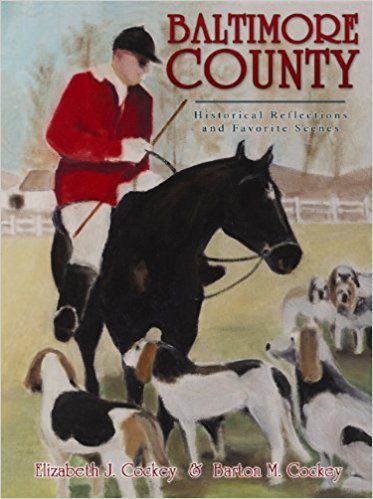
Report From Baltimore, The (Former) Monumental City: There’s A War Going On, But White Americans Don’t Know — Yet
03/22/2018
See earlier, by Eugene Gant: “What Will Come Of The Race War That Roils The Streets Of Baltimore?”
The new tribe is growing bolder and is taking down the totems of the old tribe. Baltimore used to be called “The Monumental City” but its now-majority-black council and its black mayor notoriously removed four monuments — to Robert E. Lee and Stonewall Jackson, to U.S. Chief Justice Roger B. Taney, to Confederate Soldiers and Sailors and to Confederate Women — during the Night of the Long Cranes, August 16, 2017.
This month, the city held a ceremony rededicating the Lee-Jackson site as the “Harriet Tubman Memorial Grove,” One Jackson Gilman-Forlini (right) a white activist who works for the city as a “historic preservationist” was quoted extruding a prime blob of post-modern nonsense:
“Monuments are seen as permanent, sort of monolithic structures, but inherently their meanings change over time, and really the removal of these monuments was not so much about monuments in general, but about the kind of values that we as a society want to promote…of inclusion, of tolerance, of speaking out against prejudice.” [Baltimore park space where Confederate statue once stood is rededicated to Harriet Tubman, by Kevin Rector, Baltimore Sun, March 10, 2018]But tolerance of what? And with “preservationists” like Gilman-Forlini, who needs destructionists?
I have a personal interest in this matter. I grew up in the neighborhood where two of the vandalized monuments stood. My 6 times great-grandfather John Cockey served on the first commission to lay plans for Baltimore Town in 1720. Previously, his father, William, was among the first settlers of the region in the 17th century.
Baltimore was occupied quickly and brutally by Union forces at the beginning of the War Between The States, but my family were Southern sympathizers and one was imprisoned on the evidence of an informer. The suburban eyesore called Cockeysville, which used to be a pretty country village, is named after us. My last name is most often displayed these days on the vehicles of a waste management company owned by a very distant cousin. People occasionally ask me whether I really am cocky, and I reply that it’s hard to be humble when your name is on so many dumpsters.
I am also a complete product of Baltimore’s Johns Hopkins University, BA, MD, residency and instructorship in diagnostic radiology at Johns Hopkins Hospital. I was even born at Hopkins Hospital. For thirty years, I practiced medicine in the Baltimore area and lived in a pleasant part of northern Baltimore City.
But now we have left Baltimore for good.
By the time we left, black teens were stealing packages off the front porch, white heroin addicts were breaking into the carriage house, and the police were advising residents to lock their second-floor windows and avoid going out alone or at night. Black teenage carjackers shot a man about eighty yards from my front door.
The police occasionally caught the perps, but the courts released them because they were under-aged. The State of Maryland makes it almost impossible for a normal person to obtain a concealed carry permit, but even if you could get one, you would be better off dead than having to deal with the legal repercussions of shooting a black criminal.
This, then, is the background for Baltimore city government’s brilliant idea: spending over a million dollars to remove historic monuments. (Is the Pope going to take down the Colosseum?)
I’m only going to comment here on two victims of this vandalism. But first a story:
Several years ago, my wife Elizabeth gave a birthday party for me in Baltimore. A composer friend sat down at the piano and announced that he was going to play a new composition entitled “Heroes.” By way of preamble, and in order to inform his performance by having a specific person in mind, he asked me to name a hero of my own. That was a tough question because there are so many people I admire. So, rather than dither, I immediately replied, “Robert E. Lee.”
There was a gasp from the other side of the room, and I realized it had come from a black lady who is a friend of Elizabeth’s. I immediately jumped to the Main Stream Media-programmed conclusion that my choice had offended her. At the end of the evening, as we were saying our good-byes, she told me, “I can’t believe you said Robert E. Lee!”
I replied, “Oh?”
“Yes,” she exclaimed with great animation. “He’s my hero too!”
I mention this little exchange because identity politics has become so pervasive that the default assumption is that opinions divide along racial lines. We ought to be able to share some of our heroes.
If white people can learn something valuable from the tale of a Tubman — although actually the creation of 20th Century Communist propaganda — why can’t black people profit from the legend of a Lee?
My two comments (for now):
- The only thing that everybody now knows about Roger Brooke Taney is his role in the Dred Scott case of 1857. But Taney served on the court for 28 years, and some of his other decisions are much-applauded — including, interestingly, Prigg v. Pennsylvania (1842), which insisted on the positive responsibility of states to enforce federal fugitive slave laws. Whether those laws were good laws is beside the point if you believe that judges should not legislate from the bench.
But let the record show that the Democratic Mike Miller, President of the Maryland Senate, denounced the move and
…said the statue should stay put to help educate people about the past. He credited Taney for ‘anti-slavery words and actions,’ saying that ‘unlike George Washington who freed his slaves upon his death, Taney freed his slaves early in his life.’ He also noted Taney’s many roles in public service including state lawmaker and attorney general, secretary of war, U.S. attorney general and U.S. treasury secretary.”When the state’s leading Republican has less sense than the leading Democrat, we’re in trouble.Justice Taney defended slavery in 1857. Now his statue is gone from Md.’s State House.
By Josh Hicks and Ovetta Wiggins, August 18, 2017
But we know that.
- The most shameful of all the recent monumental vandalisms, however: the removal of the Confederate Women’s Monument.
Funded by the United Confederate Veterans, the United Daughters of the Confederacy, and the State of Maryland, it was dedicated in 1917 in honor of “The Brave at Home.” The back side of the granite base reads as follows:
Evidently, selflessness, generosity, and kindly solicitude are not that “kind of values” that Baltimore’s “historical preservationist” Jackson Gilman-Forlini thinks we should “promote.”
IN DIFFICULTY AND DANGER
REGARDLESS OF SELF
THEY FED THE HUNGRY
CLOTHED THE NEEDY
NURSED THE WOUNDED
AND COMFORTED THE DYING
A black Hopkins professor named N.D.B. Connolly, who is billed by Hopkins as “an expert in politics, capitalism, and racism” said of renaming the Lee-Jackson site, whose empty plinth is pictured right:
current inequalities relating to mass incarceration, eviction, public health — all these things fall disproportionately on black women. Anything we can do to claim space to honor and respect the contributions of black women is really important.Very well, Professor, why don’t you and your successful black buddies pay for the construction of a statue honoring black women?Harriet Tubman, real-life action hero
By Saralyn Cruickshank, The Johns Hopkins Hub, March 8, 2018
Oh, right, you think the rest of us owe you.
I am all in favor of honoring black women, but why do you have to take down a statue honoring white women?
The answer to this last question is becoming disturbingly evident: there is, despite Gilman-Forlini, no “tolerance.” For the black radicals and other anti-white identity groups, it’s us versus them.
Remember when Americans woke up after 9/11 to find that someone was waging war against us but we didn’t know it?
Well, unfortunately it’s time to wake up again.
Barton Cockey, MD is a 9th-generation Marylander and an author and lecturer. He has a lifelong interest in the history and traditions of our country and has co-authored a number of books including the illustrated history Baltimore County, Historical Reflections and Favorite Scenes.




